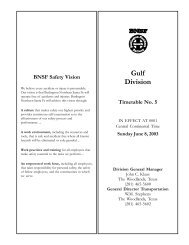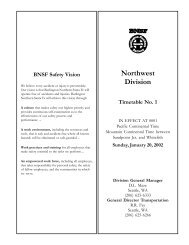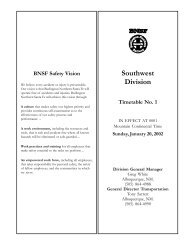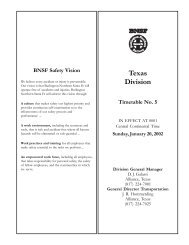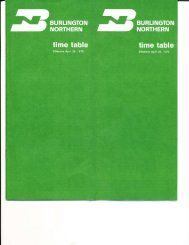2 11/5/03 - Friends of the Burlington Northern Railroad
2 11/5/03 - Friends of the Burlington Northern Railroad
2 11/5/03 - Friends of the Burlington Northern Railroad
You also want an ePaper? Increase the reach of your titles
YUMPU automatically turns print PDFs into web optimized ePapers that Google loves.
56 NORTHWEST DIVISION—No. 2—November 5, 20<strong>03</strong>—Scenic Subdivision<br />
Mukilteo/Boeing Hill Operation—Crews that operate on<br />
Boeing Hill must have a copy <strong>of</strong>, and be conversant with, <strong>the</strong><br />
“Boeing Hill Instructions.”<br />
Richmond Beach—Cars left on tracks 901 and 902 must be<br />
shoved to <strong>the</strong> Walk Bridge MP 13.86.<br />
Derails—The 2 derails located between Airport Road Crossing<br />
and Snohomish Jct. West, on <strong>the</strong> Woodinville Subdivision may<br />
be left in <strong>the</strong> <strong>of</strong>f position unless protecting cars, engines or<br />
equipment.<br />
Mountain Grade Operation<br />
Air Brake and Train Handling Rules for mountain grade<br />
operation apply on mountain grade between Skykomish and<br />
Berne, ruling grade ascending east 2.2; and between Berne<br />
and Merritt, ruling grade descending east 2.2.<br />
The maximum number <strong>of</strong> powered axles in head end consist<br />
ascending mountain grade must not exceed 36.<br />
The speed <strong>of</strong> trains must be controlled, at least in part, with<br />
automatic air brake when train tonnage exceeds 3,500 tons<br />
when operating on descending grades - MP 1731.3 to MP<br />
1709.0 and MP 1700.5 to MP 1694.5.<br />
ABTH Rule 102.12.6 Distributed Power /Helper Limitations<br />
and Placement, <strong>the</strong> following exception applies:<br />
H EVEGAL and M SPOEVE symboled trains are exempt from<br />
<strong>the</strong> formula for helper position requirements and <strong>the</strong> following<br />
will apply:<br />
DP/Helper consists must be cut in not less than one half <strong>the</strong><br />
rated tonnage, nor more than <strong>the</strong> full rated tonnage <strong>of</strong> <strong>the</strong><br />
consist.<br />
Locomotive Ratings to be Utilized for Helper Placement<br />
Only<br />
DC Locomotives<br />
1500-2999 hp = 1000 tons<br />
3000-3999 hp = 1500 tons<br />
4000 hp + = 2000 tons<br />
AC Locomotives = 2500 tons<br />
TRAIN SIZE/COUPLER CAPACITY LIMITATIONS<br />
BETWEEN MERRITT AND SKYKOMISH<br />
For <strong>the</strong> purpose <strong>of</strong> identifying coupler capacity limitations on<br />
<strong>the</strong> Scenic Subdivision:<br />
Grade C equipment (General Service) is rated at 4,800 tons<br />
Grade E equipment is rated at 6,000 tons<br />
Doublestack equipment and Boeing cars will be considered to<br />
be equipped with Grade E equipment for <strong>the</strong> purpose <strong>of</strong><br />
coupler capacity limitations. All o<strong>the</strong>r car types will be<br />
considered Grade C equipment in <strong>the</strong> application <strong>of</strong> <strong>the</strong><br />
following instructions.<br />
If it is not known that a car is equipped with high strength<br />
couplers, it can be determined by looking at <strong>the</strong> coupler<br />
casting identification located on top <strong>of</strong> <strong>the</strong> coupler. A high<br />
strength coupler will have <strong>the</strong> letter “E” as <strong>the</strong> LAST character<br />
<strong>of</strong> identification. Examples <strong>of</strong> high strength coupler<br />
identifications are E60THE, SBE60CE, and E60DE.<br />
NOTE: The term “helpers”, in instructions below applies to<br />
both manned helper and distributed power remote locomotive<br />
consists. All length limitations exclude locomotives.<br />
TRAIN LENGTH/COUPLER CAPACITY LIMITATION<br />
WITHOUT HELPERS<br />
GRADE C EQUIPMENT - 4,800 tons, 7,000 feet<br />
ALL GRADE E EQUIPMENT OR MIXED GRADE C AND E -<br />
6,000 tons, 7,000 feet (All Grade C equipment must be placed<br />
so that is has no more than 4,800 trailing tons.)<br />
Except Westbound Intermodal trains maximum total train<br />
length including power must not exceed 8,000 feet.<br />
TRAIN LENGTH/COUPLER CAPACITY LIMITATION WITH<br />
HELPERS<br />
9,600 tons and 7,700 feet<br />
EXCEPTION: 7,700 feet limitation does not apply to Distributed<br />
Power trains.<br />
NOTE: Coupler capacity limits above for non-helper trains<br />
apply to trailing tonnage behind helper placement.<br />
Instructions Governing Operation <strong>of</strong> Trains Between<br />
Merritt and Skykomish<br />
A. Skykomish—Siren located at Main Street crossing is<br />
under control <strong>of</strong> <strong>the</strong> City Fire Department. When<br />
activated, an emergency exists. The crossing must not<br />
be blocked and trains occupying must clear or cut it<br />
immediately.<br />
B. Merritt—Light helper locomotives or o<strong>the</strong>r light<br />
locomotives left unattended will be placed on west leg <strong>of</strong><br />
wye, complying with Air Brake and Train Handling Rules.<br />
C. Helper units on eastward freight trains between MP<br />
1708.3 east switch Scenic and MP 1700.0 east portal<br />
Cascade Tunnel will not exceed sixth throttle position.<br />
D. Scenic—Two white lights flashing alternately are mounted<br />
in a vertical position on a bracket attached to <strong>the</strong> power<br />
pole just east <strong>of</strong> east switch on south side <strong>of</strong> main track<br />
to indicate that <strong>the</strong> ventilating system is functioning.<br />
Eastward trains must not pass Scenic unless alternate<br />
flashing white lights are operating unless permission is<br />
given by train dispatcher. Exception: Eastward passenger<br />
trains, not exceeding two locomotives in <strong>the</strong> engine<br />
consist, may pass Scenic and enter Cascade Tunnel<br />
without <strong>the</strong> ventilating system functioning unless<br />
o<strong>the</strong>rwise directed by <strong>the</strong> train dispatcher. Repeater<br />
ventilating system indicators are located at MP 1704.2<br />
and MP 1702.4 in Cascade Tunnel.<br />
Eastward trains between Scenic and Berne before<br />
entering west portal Cascade Tunnel No. 15 will advise<br />
Seattle East dispatcher if <strong>the</strong>y have aluminum ore, and<br />
Seattle East dispatcher will activate <strong>the</strong> tunnel circuit,<br />
which will open <strong>the</strong> louvers, relieving pressure on this<br />
train. Eastward trains handling aluminum ore: do not<br />
exceed 15 MPH between bay <strong>11</strong> and bay 6, and at bay 6<br />
gradually reduce speed not exceeding 10 MPH between<br />
bay 4 and east portal, advising Seattle East dispatcher as<br />
soon as engines clear east portal. Helper consist not<br />
permitted in trains requiring alternate ventilation.<br />
E. Ventilating fans and tunnel door are located at <strong>the</strong> east<br />
portal <strong>of</strong> Cascade Tunnel. Westward absolute signal at<br />
MP 1700.3 is located 65 feet east <strong>of</strong> tunnel door, and<br />
eastward absolute signal at MP 1700.4 is located 100 feet<br />
west <strong>of</strong> tunnel door. When a train or engine is stopped by<br />
ei<strong>the</strong>r <strong>of</strong> <strong>the</strong>se signals, in addition to <strong>the</strong> usual<br />
observance <strong>of</strong> rules, contact with <strong>the</strong> train dispatcher<br />
must be made and great care must be taken before<br />
proceeding to see that <strong>the</strong> tunnel door is in <strong>the</strong> fully<br />
opened position.<br />
If Cascade Tunnel door is closed, immediately contact<br />
train dispatcher and be governed by his instructions.<br />
Ascertain which door is in operation. New tunnel door is<br />
red-and-white checkerboard and is located east <strong>of</strong> <strong>the</strong> old<br />
door.<br />
If old door is closed and if instructed to manually open <strong>the</strong><br />
door, ascend <strong>the</strong> ladder on <strong>the</strong> south wall to top <strong>of</strong> door<br />
and cross catwalk to <strong>the</strong> north side. Face door and move




